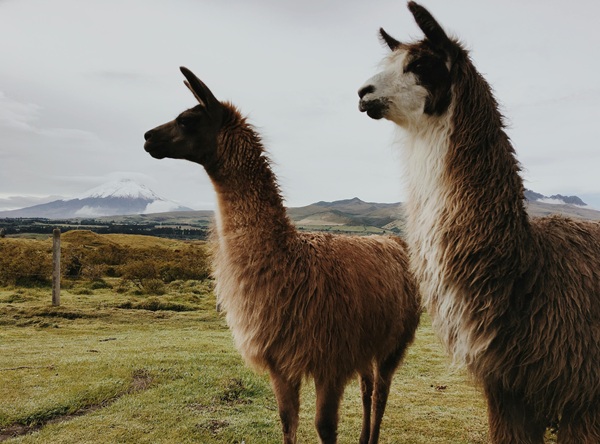
Llamas and alpacas are becoming more popular. They can also be a good livestock investment and be good pets. Listed below are the answers to the most common questions about them.
Where are They Originally From?
Llamas and alpacas come from Peru, Bolivia, and Chile, in the high plains areas called the Altiplano (elevation: 8,000’-15,000’). Llamas were first brought to the United States by William Randolph Hearst in the 1920’s for his personal zoo. Alpacas were imported much more recently, beginning in the ‘80s. Llamas and alpacas were domesticated from their wild counterparts, the Guanaco and Vicuna 6,000-7,000 years ago by the Quechua Indians and their fiber and structure were improved by the Incas.
What Kind of Personality Does a Llama Have?
Llamas by nature, are very intelligent, gentle animals. They are relatively inexpensive to maintain, relatively disease-free, and are quick to learn, cooperative, and patient in training. Their quickness to learn can make them, at times, mischievous.
Do They Spit?
This is the all-time most popular question about llamas and alpacas. The answer is yes, they do spit, but usually at each other, primarily over disputes about food. A bred female will spit at advances from a male. An overhandled animal, improperly socialized without other llamas/alpacas present, will think humans are llamas/alpacas and will spit as a normal course of action against the other “llama/alpaca”. A mistreated or mishandled animal may also spit at humans.
What Do You Do with a Llama?
There are seven main uses for a llama, many compatible in the same animal. A pet and companion. A sure-footed, alert pack animal. A source of excellent fiber (like alpaca). An animal trained to pull a cart. A show competitor: 4-H Projects, parades. A competent guard animal, very effective against small predators. A breeding animal, as a source of income
What’s the Difference Between an Alpaca and a Llama?
The two primary differences are size and fiber quality. Llamas were primarily bred to be a beast of burden, and alpacas were bred primarily as fiber producers. An average alpaca standing 34”-36” at the withers, where llamas stand 42”-48” at the withers. An adult alpaca will generally produce 5-8 pounds of high-quality exotic uniformly crimped fiber in a single fiber fleece, each year.
Can You Ride Them?
It is not generally recommended to ride llamas, except for small children. An adult male will reach a weight of between 300 and 450lbs. and stand 5 to 6 feet tall. They are expected to carry approximately 1/4 of their body weight, so a rider or load of between 75-115 lbs. may be carried. This weight may be increased to a maximum of 1/3 of their body weight as they reach top physical conditioning.
Can You Take Them Back-Packing?
Llamas and/or Alpacas are great friends to have when you want to head to the high country for a little camping and back-country trekking. Because of their soft foot (two toes, with toenails) they leave no scars on the trail. Because they are modified ruminants, their fecal matter comes as very well digested, almost odorless pellets. They can usually browse for their food as they go along the trail. All in all, they fit into the mountain trail or back-country environment very well.
Do They Bite or Kick
They do not bite or kick like a horse. A human isn’t in danger of being kicked or bitten by a properly socialized and desensitized animal. They will kick at a fly or something around their back feet, but because the foot is soft it’s just not as dangerous as a horse’s kick and isn’t used as a primary self-defense measure.
Is Their Manure Good Fertilizer?
It is excellent fertilizer and may be applied to the garden immediately.
Related Articles & Free Email Newsletter Sign Up
A Horses’ Tail is Much More Than Just a Flyswatter
An Alpaca Can Be Both a Farm Animal and a Pet


Comment here